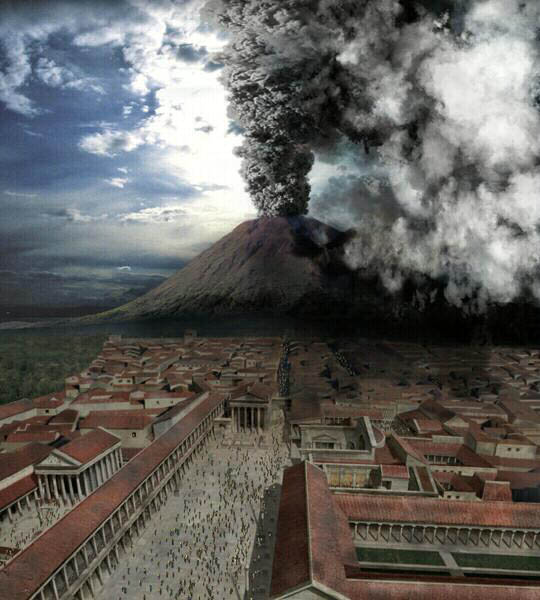
A really big news day
In 79AD, a really big news story hit the Roman Empire.
Mt. Vesuvius, an active volcano in Italy erupted and destroyed the cities of Herculaneum and Pompeii.
The news story, however, did not make air until 1738AD, some 1600 years later.
Unlike the Iceland volcano, the Vesuvius eruption was accompanied by a cloud of poison gas which killed anyone who inhaled it. (We can consider ourselves lucky with Iceland – life often hangs by a tenuous thread). The cities of Pompeii and Herculaneum were then buried in the kind of fine ash that is now hanging over Western Europe and pumice. The ash buried both cities, (along with the dead bodies) and preserved them in a kind of cement-like encasement until 1738, when they were uncovered by workmen digging a foundation for a new palace for Charles deBourbon, King of Naples.
What makes this interesting for us however, is not the burial of Pompeii, but rather the discovery.
Pompeii was the first place that true, intact remnants of the Roman Empire were uncovered. It set off a spate of excavating and an interest in what had been a hitherto almost forgotten past.
The heat and scouring power of the volcanic ash and pumice had a curious effect on the Roman statuary and buildings in Pompeii – it bleached them white.
The statues and columns that were excavated were pristine, in a way, and 18th Century Europeans got the impression that Roman and Greek statuary were all pristine and white and pure. That was how the ancient world was supposed to look.
Ironically, as it turns out, Roman and Greek statues and buildings were in fact a riot of color.
The Parthenon, which is so often represented as pure and blindingly white, in fact looked more like Venice Beach, California when it was up and running. The statues of the Greeks and the Romans were not only painted bright colors but often had detachable wigs.
But our first perception of the bleached statuary and buildings became so entrenched in our thinking that it became the standard for ‘perfection’, even if had nothing to do with historical reality.
The many buildings that dot Washington DC, for example, imitations of Greek architecture – the Capitol, The Lincoln Memorial, The Supreme Court and so on, should, really, be painted bright reds and blues and greens if they really wanted to capture the spirit of ancient Greece. They aren’t.
As excavation continue apace, archaeologists inevitably began to dig up statuary that had not suffered the bleaching effects of Vesuvius and still retained some traces of color. 19th and 20th Century archaeologists spent lots of time actually ‘cleaning’ the statues to ‘restore’ them to their ‘natural’ pristine state.
Weird.
Now, what does this have to do with journalism?
It is a kind of natural human instinct that that which we see or experience first becomes the standard forever, regardless of what we might later see around us. We don’t take change well, or sometimes at all.
Our models for how journalism should be done, what it should look like and who we can ‘trust’ were cast in the late 19th century. One sole reporter seeking ‘the truth’. This model held true for print, radio and TV.
In fact, new technologies are often bent to support what can become an unsupportable architecture; and sometimes even a crippling one.
It is, in many ways, as wrong as the pristine white statuary at the Met. Yet it persists and anything that deviates from it is viewed as ‘upsetting’ or just plain wrong.
Pompeii was, incidentally, first uncovered in 1599 by the architect Domenico Fontana. But the frescos and statuary that he uncovered were of a graphic sexual nature – such was daily life in Rome. The authorities found this so upsetting that they ordered the artifacts to be re-buried.
Some people think you can’t hold back progress. But you can.
Just look around you.